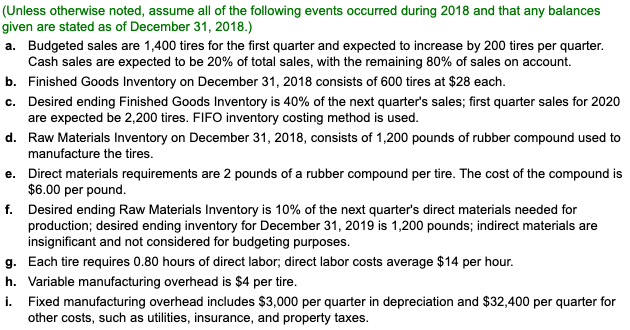
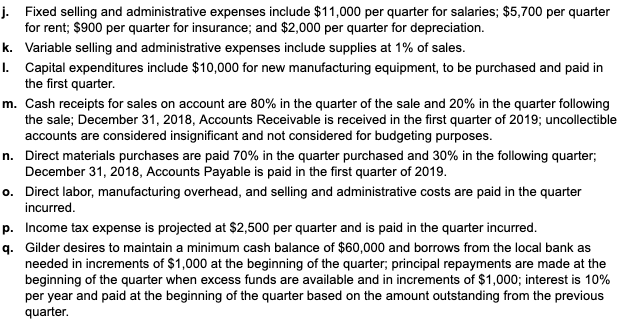
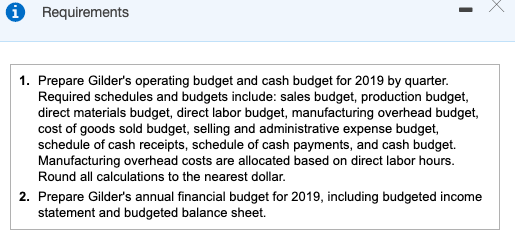

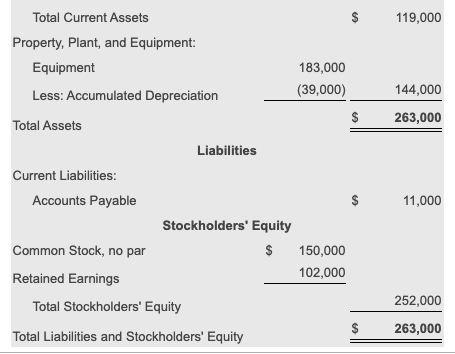
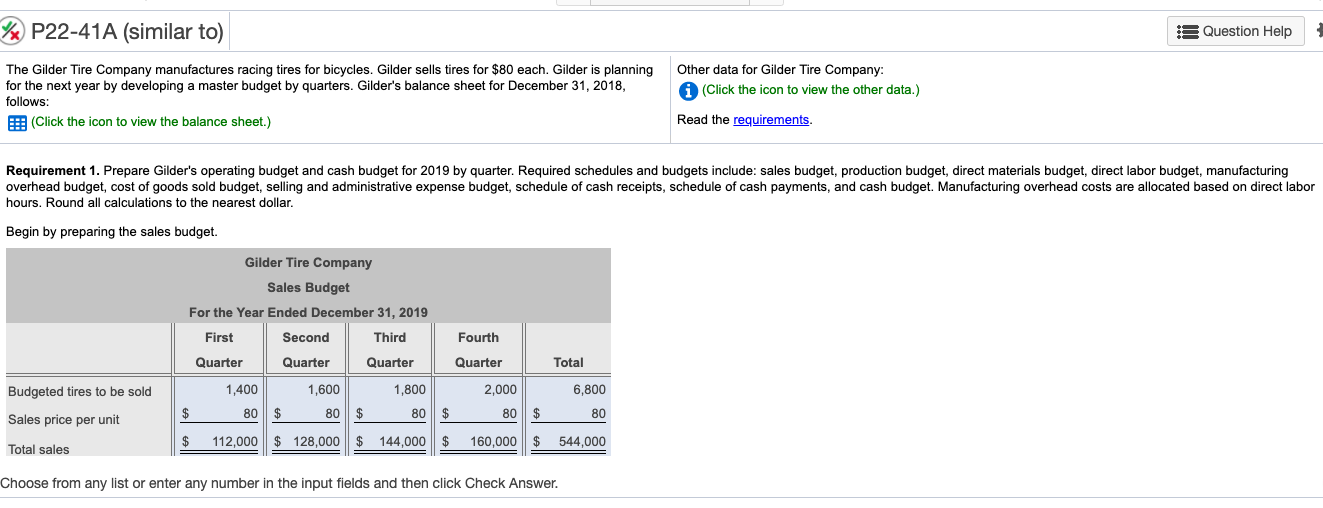
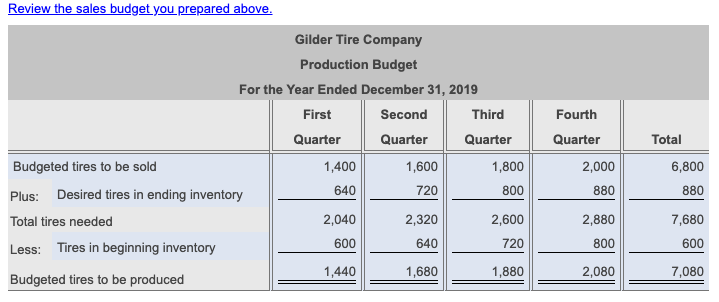
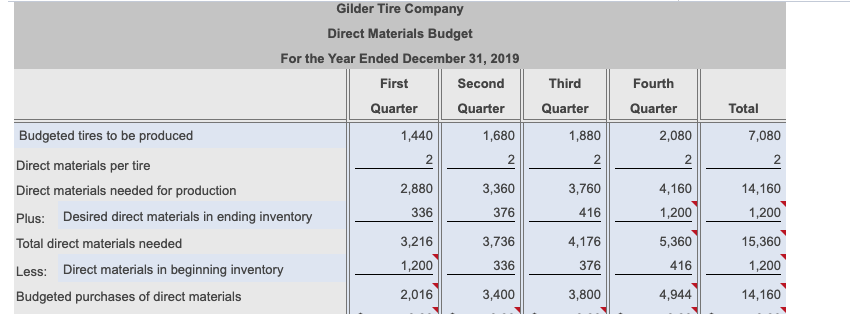

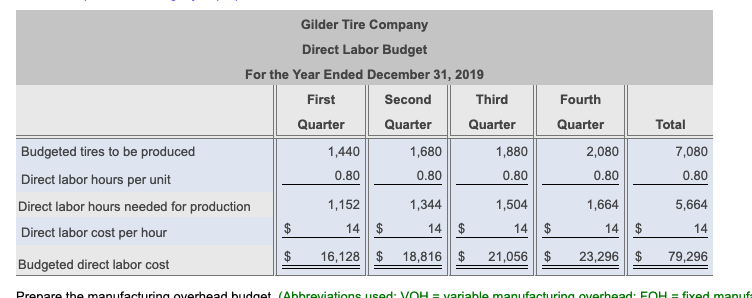
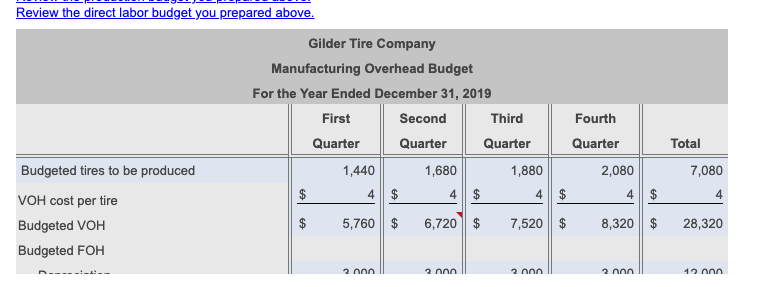
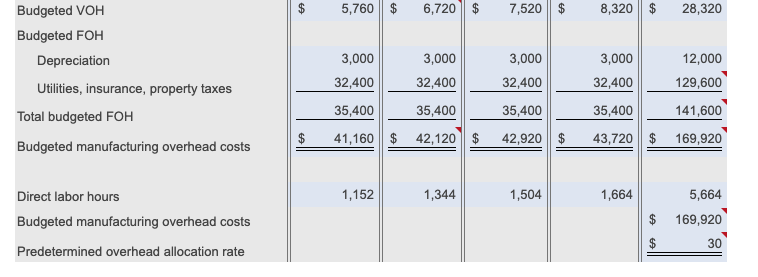


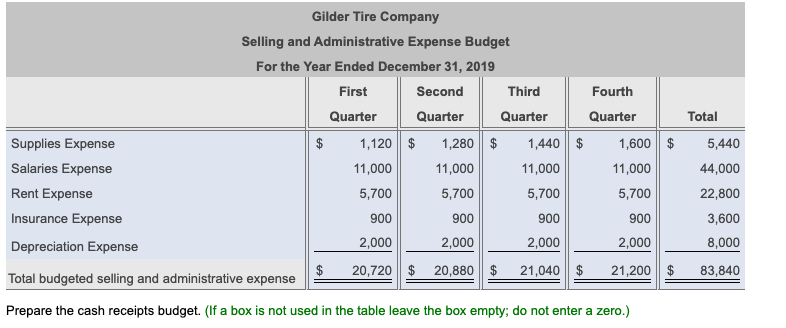
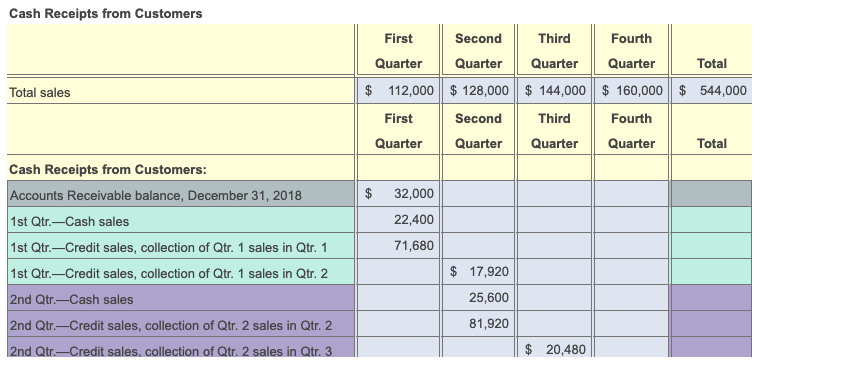
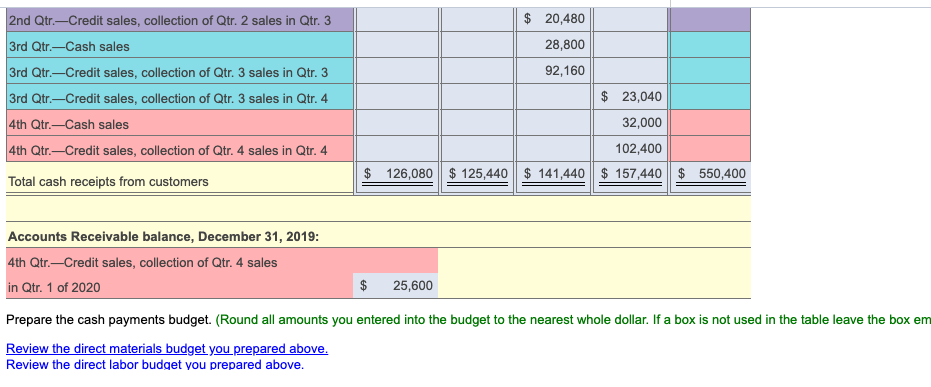
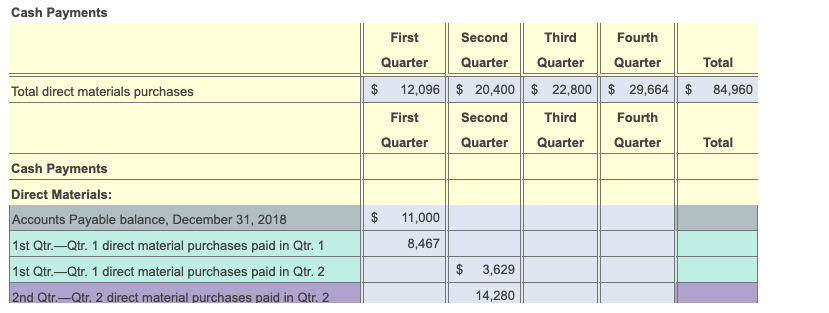





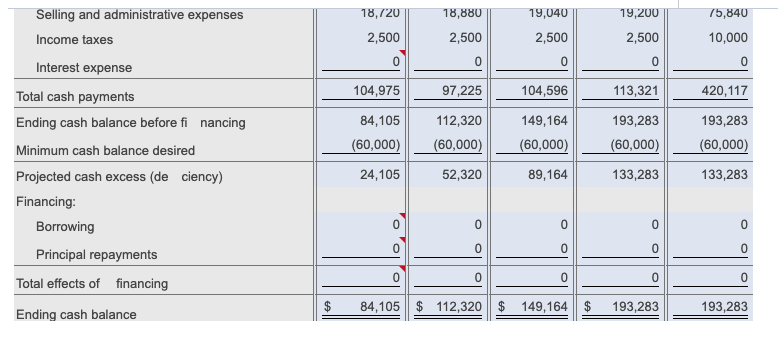
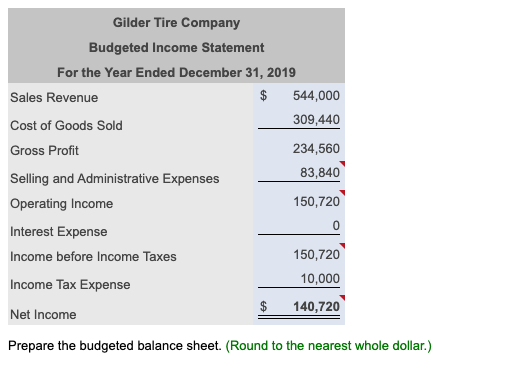

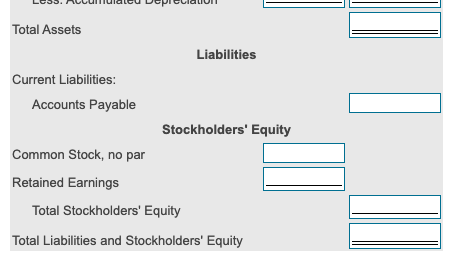
(Unless otherwise noted, assume all of the following events occurred during 2018 and that any balances given are stated as of December 31, 2018.) a. Budgeted sales are 1,400 tires for the first quarter and expected to increase by 200 tires per quarter. Cash sales are expected to be 20% of total sales, with the remaining 80% of sales on account. b. Finished Goods Inventory on December 31, 2018 consists of 600 tires at $28 each. C. Desired ending Finished Goods Inventory is 40% of the next quarter's sales; first quarter sales for 2020 are expected be 2,200 tires. FIFO inventory costing method is used. d. Raw Materials Inventory on December 31, 2018, consists of 1,200 pounds of rubber compound used to manufacture the tires. e. Direct materials requirements are 2 pounds of a rubber compound per tire. The cost of the compound is $6.00 per pound. f. Desired ending Raw Materials Inventory is 10% of the next quarter's direct materials needed for production; desired ending inventory for December 31, 2019 is 1,200 pounds; indirect materials are insignificant and not considered for budgeting purposes. g. Each tire requires 0.80 hours of direct labor, direct labor costs average $14 per hour. h. Variable manufacturing overhead is $4 per tire. i. Fixed manufacturing overhead includes $3,000 per quarter in depreciation and $32,400 per quarter for other costs, such as utilities, insurance, and property taxes. j. Fixed selling and administrative expenses include $11,000 per quarter for salaries; $5,700 per quarter for rent; $900 per quarter for insurance; and $2,000 per quarter for depreciation. k. Variable selling and administrative expenses include supplies at 1% of sales. 1. Capital expenditures include $10,000 for new manufacturing equipment, to be purchased and paid in the first quarter. m. Cash receipts for sales on account are 80% in the quarter of the sale and 20% in the quarter following the sale; December 31, 2018, Accounts Receivable is received in the first quarter of 2019; uncollectible accounts are considered insignificant and not considered for budgeting purposes. n. Direct materials purchases are paid 70% in the quarter purchased and 30% in the following quarter; December 31, 2018, Accounts Payable is paid in the first quarter of 2019. o. Direct labor, manufacturing overhead, and selling and administrative costs are paid in the quarter incurred. p. Income tax expense is projected at $2,500 per quarter and is paid in the quarter incurred. 9. Gilder desires to maintain a minimum cash balance of $60,000 and borrows from the local bank as needed in increments of $1,000 at the beginning of the quarter, principal repayments are made at the beginning of the quarter when excess funds are available and in increments of $1,000; interest is 10% per year and paid at the beginning of the quarter based on the amount outstanding from the previous quarter. Requirements 1. Prepare Gilder's operating budget and cash budget for 2019 by quarter. Required schedules and budgets include: sales budget, production budget, direct materials budget, direct labor budget, manufacturing overhead budget, cost of goods sold budget, selling and administrative expense budget, schedule of cash receipts, schedule of cash payments, and cash budget. Manufacturing overhead costs are allocated based on direct labor hours. Round all calculations to the nearest dollar. 2. Prepare Gilder's annual financial budget for 2019, including budgeted income statement and budgeted balance sheet. $ Gilder Tire Company Balance Sheet December 31, 2018 Assets Current Assets: Cash 63,000 Accounts Receivable 32,000 Raw Materials Inventory 7,200 Finished Goods Inventory 16,800 Total Current Assets $ Property, Plant, and Equipment: Equipment 183,000 Less: Accumulated Depreciation (39,000) $ Total Aceste 119,000 144,000 263,000 119,000 144,000 263,000 $ Total Current Assets $ Property, Plant, and Equipment: Equipment 183,000 Less: Accumulated Depreciation (39,000) $ Total Assets Liabilities Current Liabilities: Accounts Payable Stockholders' Equity Common Stock, no par $ 150,000 Retained Earnings 102,000 Total Stockholders' Equity $ Total Liabilities and Stockholders' Equity $ 11,000 252,000 263,000 P22-41A (similar to) :3 Question Help The Gilder Tire Company manufactures racing tires for bicycles. Gilder sells tires for $80 each. Gilder is planning for the next year by developing a master budget by quarters. Gilder's balance sheet for December 31, 2018, follows: : (Click the icon to view the balance sheet.) Other data for Gilder Tire Company: A (Click the icon to view the other data.) Read the requirements. Requirement 1. Prepare Gilder's operating budget and cash budget for 2019 by quarter. Required schedules and budgets include: sales budget, production budget, direct materials budget, direct labor budget, manufacturing overhead budget, cost of goods sold budget, selling and administrative expense budget, schedule of cash receipts, schedule of cash payments, and cash budget. Manufacturing overhead costs are allocated based on direct labor hours. Round all calculations to the nearest dollar. Begin by preparing the sales budget. Gilder Tire Company Sales Budget For the Year Ended December 31, 2019 First Second Third Quarter Quarter Quarter Budgeted tires to be sold 1,400 1,600 1,800 $ 80 $ 80 80 $ Sales price per unit $ Total sales 112,000 | $ 128,000 | $ 144,000 Fourth Quarter Total 2,000 6,800 $ 80 $ 80 $ 160,000 $ 544,000 Choose from any list or enter any number in the input fields and then click Check Answer. Review the sales budget you prepared above. Total Gilder Tire Company Production Budget For the Year Ended December 31, 2019 First Second Third Quarter Quarter Quarter Budgeted tires to be sold 1,400 1,600 1,800 640 Plus: Desired tires in ending inventory 720 800 Total tires needed 2,040 2,320 2,600 600 640 720 Less: Tires in beginning inventory 1,440 1,680 1,880 Budgeted tires to be produced Fourth Quarter 2,000 880 6,800 880 2,880 800 7,680 600 2,080 7,080 Third Quarter 1,880 Fourth Quarter 2,080 Total 7,080 Gilder Tire Company Direct Materials Budget For the Year Ended December 31, 2019 First Second Quarter Quarter Budgeted tires to be produced 1,440 1,680 2 Direct materials per tire Direct materials needed for production 2,880 3,360 Plus: Desired direct materials in ending inventory 336 376 Total direct materials needed 3,216 3,736 Less: 336 Direct materials in beginning inventory 1,200 Budgeted purchases of direct materials 2,016 3,400 2 2 2 2 3,760 4,160 14,160 1,200 416 1,200 4,176 5,360 15,360 1,200 376 416 3,800 4,944 14,160 3,736 5,360 3,216 1,200 4,176 376 15,360 1,200 336 416 Total direct materials needed Less: Direct materials in beginning inventory Budgeted purchases of direct materials Direct materials cost per pound Budgeted cost of direct materials 3,800 2,016 6.00 $ 3,400 6.00 $ 4,944 6.00 $ 14,160 6.00 6.00 $ 12,096 $ 20,400 $ 22,800 $ 29,664 $ 84,960 Prepare the direct labor budget. (Enter any hours per unit amounts to two decimal places, X.XX, and round all other amounts to the nearest whole number.) Review the production budget you prepared above. Total Gilder Tire Company Direct Labor Budget For the Year Ended December 31, 2019 First Second Third Fourth Quarter Quarter Quarter Quarter Budgeted tires to be produced 1,440 1,680 1,880 2,080 Direct labor hours per unit 0.80 0.80 0.80 0.80 Direct labor hours needed for production 1,152 1,344 1,504 1,664 Direct labor cost per hour 14 14 14 || $ 14 16,128 | $ 18,816 Budgeted direct labor cost 21,056 $ 23,296 7,080 0.80 5,664 14 79,296 Prepare the manufacturing overhead budget (Abbreviations used. VOH = variable manufacturing overhead. FOH = fived manuf Review the direct labor budget you prepared above. Gilder Tire Company Manufacturing Overhead Budget For the Year Ended December 31, 2019 First Second Third Fourth Quarter Quarter Quarter Quarter Budgeted tires to be produced 1,440 1,680 1,880 2,080 VOH cost per tire 4$ 4$ 4 || $ 4||$ Budgeted VOH 5,760 $ 6,720$ 7,520 | $ 8,320 $ Budgeted FOH Total 7,080 4 $ $ 28,320 -------- 2 nnn 2 nnn 2 nnn 2 nnn 12nnn $ 5,760 | $ 6,720 $ 7,520 $ 8,320 $ 28,320 Budgeted VOH Budgeted FOH Depreciation Utilities, insurance, property taxes Total budgeted FOH Budgeted manufacturing overhead costs 3,000 32,400 3,000 32,400 3,000 32,400 3,000 32,400 12,000 129,600 35,400 35,400 35,400 35,400 141,600 $ 41,160 $ 42,120$ 42,920 | $ 43,720 $ 169,920 1,152 1,344 1,504 1,664 5,664 Direct labor hours Budgeted manufacturing overhead costs $ 169,920 30 Predetermined overhead allocation rate Before preparing the cost of goods sold budget, calculate the projected manufacturing cost per tire for 2019. (Round all amounts to the nearest cent.) Direct materials cost per tire 12.00 Direct labor cost per tire 11.20 Manufacturing overhead cost per tire 24.00 47.20 Total projected manufacturing cost per tire for 2019 Now prepare the cost of goods sold budget. Review the sales budget you prepared above. Choose from any list or enter any number in the input fields and then click Check Answer. Gilder Tire Company Cost of Goods Sold Budget For the Year Ended December 31, 2019 First Second Third Fourth Quarter Quarter Quarter Quarter Beginning inventory 16,800 $ Tires produced and sold in 2019 37,760 $ 75,520 $ 84,960 $ 94,400 54,560 $ 75,520 $ 84,960 $ 94,400 || $ Total budgeted cost of goods sold Prepare the selling and administrative expense budget. Total 16,800 292,640 309,440 Total Gilder Tire Company Selling and Administrative Expense Budget For the Year Ended December 31, 2019 First Second Third Fourth Quarter Quarter Quarter Quarter Supplies Expense $ 1,120 $ 1,280 $ 1,440 $ 1,600 $ Salaries Expense 11,000 11,000 11,000 11,000 Rent Expense 5,700 5,700 5,700 5,700 Insurance Expense 900 900 900 900 Depreciation Expense 2,000 2,000 2,000 2,000 $ 20,720 $ 20,880 $ Total budgeted selling and administrative expense 21,040 $ 21,200 $ Prepare the cash receipts budget. (If a box is not used in the table leave the box empty; do not enter a zero.) 5,440 44,000 22,800 3,600 8,000 83,840 Cash Receipts from Customers Total sales First Second Third Fourth Quarter Quarter Quarter Quarter Total $ 112,000 $ 128,000 $ 144,000 $ 160,000 $ 544,000 First Second Third Fourth Quarter Quarter Quarter Quarter Total $ 32,000 22,400 71,680 Cash Receipts from Customers: Accounts Receivable balance, December 31, 2018 1st Qtr.-Cash sales 1st Qtr.-Credit sales, collection of Qtr. 1 sales in Qtr. 1 1st Qtr.Credit sales, collection of Qtr. 1 sales in Qtr. 2 2nd Qtr.Cash sales 2nd Qtr.Credit sales, collection of Qtr. 2 sales in Qtr. 2 2nd Qtr.Credit sales, collection of Qtr. 2 sales in Qtr. 3 $ 17,920 25,600 81,920 $ 20,480 $ 20,480 28,800 92,160 2nd Qtr.Credit sales, collection of Qtr. 2 sales in Qtr. 3 3rd Qtr.Cash sales 3rd Qtr.Credit sales, collection of Qtr. 3 sales in Qtr. 3 3rd Qtr.Credit sales, collection of Qtr. 3 sales in Qtr. 4 4th Qtr.Cash sales 4th Qtr.Credit sales, collection of Qtr. 4 sales in Qtr. 4 Total cash receipts from customers $ 23,040 32,000 102,400 $ 126,080 $ 125,440 $ 141,440 $ 157,440 $ 550,400 Accounts Receivable balance, December 31, 2019: 4th Qtr.Credit sales, collection of Qtr. 4 sales in Qtr. 1 of 2020 $ 25,600 Prepare the cash payments budget. (Round all amounts you entered into the budget to the nearest whole dollar. If a box is not used in the table leave the box em Review the direct materials budget you prepared above. Review the direct labor budget you prepared above. Cash Payments Total direct materials purchases First Second Third Fourth Quarter Quarter Quarter Quarter Total $ 12,096 $ 20,400 $ 22,800 $ 29,664 $ 84,960 First Second Third Fourth Quarter Quarter Quarter Quarter Total 11,000 Cash Payments Direct Materials: Accounts Payable balance, December 31, 2018 1st Qtr. Qtr. 1 direct material purchases paid in Qtr. 1 1st Qtr.Qtr. 1 direct material purchases paid in Qtr. 2 2nd Qtr.-Qtr. 2 direct material purchases paid in Qtr. 2 8,467 $ 3,629 14,280 (Click the icon to view the balance sheet.) Read the requirements. 14,280 $ 6,120 15,960 2nd Qtr.Qtr. 2 direct material purchases paid in Qtr. 2 2nd Qtr. Qtr. 2 direct material purchases paid in Qtr. 3 3rd Qtr. Qtr. 3 direct material purchases paid in Qtr. 3 3rd Qtr. Qtr. 3 direct material purchases paid in Qtr. 4 4th Qtr.Qtr. 4 direct material purchases paid in Qtr. 4 Total payments for direct materials $ 6,840 20,765 27,605 $ 87,061 19,467 17,909 22,080 Direct Labor: Total payments for direct labor 16,128 18,816 21,056 23,296 79,296 6,720 7,520 8,320 Manufacturing Overhead: Variable manufacturing overhead Utilities, insurance, property taxes Total payments for manufacturing overhead 5,760 32,400 38,160 28,320 129,600 32,400 32,400 32,400 39,120 39,920 40,720 157,920 1,440 5,440 1,280 11,000 Selling and Administrative Expenses: Supplies Expense Salaries Expense Rent Expense Insurance Expense Total payments for Selling and Admin. expenses 1,120 11,000 5,700 900 18,720 1,600 11,000 5,700 5,700 900 11,000 5,700 900 19,040 44,000 22,800 3,600 75,840 900 18,880 19,200 Income Taxes: Total payments for income taxes 2,500 2,500 2,500 2,500 10,000 Capital Expenditures: Total payments for capital expenditures 10,000 10,000 $ 104,975 $ 97,225 $ 104,596 $ 113,321 $ 420,117 Total cash payments (before interest) Accounts Payable balance, December 31, 2019: 4th Qtr.Qtr. 4 direct material purchases paid in Qtr. 1 of 2020 $ 8,899 Cash Budget For the Year Ended December 31, 2019 First Second Third Fourth Quarter Quarter Quarter Quarter $ 63,000 $ 84,105 $ 112,320 $ 149,164 $ 126,080 125,440 141,440 157,440 Beginning cash balance Total 63,000 550,400 189,080 209,545 253,760 306,604 613,400 Cash receipts Cash available Cash payments: Capital expenditures Purchases of direct materials Direct labor Manufacturing overhead 10,000 0 0 10,000 19,467 17,909 18,816 39,120 22,080 21,056 16,128 27,605 23,296 40,720 87,061 79,296 157,920 38,160 39,920 Selling and administrative expenses 18,720 18,880 19,040 19,200 75,840 Income taxes 2,500 2,500 2,500 2,500 10,000 0 0 0 0 104,975 97,225 104,596 113,321 420,117 193,283 84,105 (60,000) 112,320 (60,000) 149,164 (60,000) 193,283 (60,000) (60,000) Interest expense Total cash payments Ending cash balance before financing Minimum cash balance desired Projected cash excess (de ciency) Financing: Borrowing Principal repayments Total effects of financing 24,105 52,320 89,164 133,283 133,283 0 0 0 0 0 0 0 0 0 193,283 84,105 $ 112,320 $ 149,164 $ 193,283 Ending cash balance Gilder Tire Company Budgeted Income Statement For the Year Ended December 31, 2019 Sales Revenue $ 544,000 Cost of Goods Sold 309,440 Gross Profit 234,560 Selling and Administrative Expenses 83,840 Operating Income 150,720 0 Interest Expense Income before Income Taxes 150,720 Income Tax Expense 10,000 $ Net Income 140,720 Prepare the budgeted balance sheet. (Round to the nearest whole dollar.) Gilder Tire Company Budgeted Balance Sheet December 31, 2019 Assets Current Assets: Cash Accounts Receivable Raw Materials Inventory Finished Goods Inventory Total Current Assets Property, Plant, and Equipment: Equipment Less: Accumulated Depreciation Total Assets Liabilities Total Assets Liabilities Current Liabilities: Accounts Payable Stockholders' Equity Common Stock, no par Retained Earnings Total Stockholders' Equity Total Liabilities and Stockholders' Equity

































